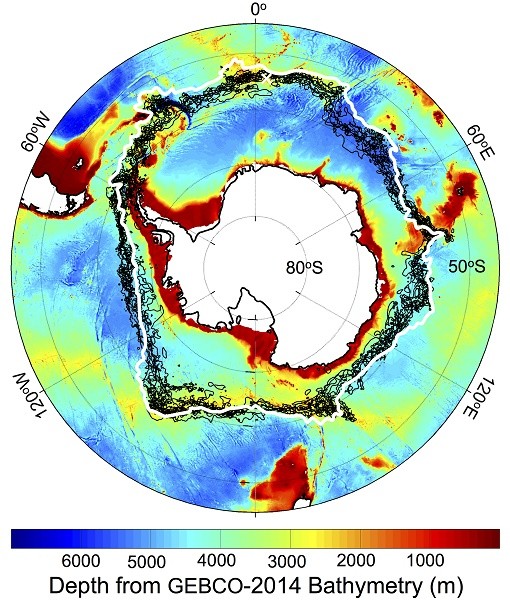The Bizarre Reason Why Antarctic Ice is Increasing While Arctic Ice is Melting
| Ana Verayo | | May 25, 2016 06:10 AM EDT |
(Photo : NASA/JPL-Caltech) Location of the southern Antarctic Circumpolar Current front (white contour), with -1 degree Celsius sea surface temperature lines (black contours) on Sept. 22 each year from 2002-2009, plotted against a chart of the depth of the Southern Ocean around Antarctica. The white cross is Bouvet Island.
Arctic ice extent and thickness is now decreasing at a rapid rate, however, on the opposite end of this polar region, Antarctic ice surrounding the southern polar regions refuses to retreat, even going to the other direction.
Between 2012 to 2014, record highs were observed in Antarctica during winter ice extent when it returned to normal levels in 2015, despite warmer water temperatures in the Southern Ocean. Scientists and researchers are extremely baffled by this phenomenon, where theories circulating involve that there might be an ozone hole above Antarctica that triggers powerful winds that generates more sea ice or melting glaciers and ice shelves that are replenishing the sea's surface, resulting in a higher freezing point.
Like Us on Facebook
In a new study, scientists aim to solve the mystery behind Antarctica's irreversible sea ice as researchers argue that there are two major geological factors for this, which is the topography of the southern polar region and the ocean depths surrounding it, which can greatly influence ocean currents and winds, that are now shaping the region's sea ice cover.
During summers in Antarctica, sea ice cover almost completely melts and disappears, unlike in the Arctic. Just last February, Antarctic sea ice extent was on average an estimated 17 percent of last September's peak, which rebuilds and replenishes itself during every fall and winter.
In this new study, NASA's Jet Propulsion Laboratory scientists analyzed radar data from NASA's QuikScat satellite in order to trace sea ice paths and movements in the Antarctic and map out different types. According to NASA JPL's Son Nghiem, early on during the growth season, sea ice is apparently pushed offshore by winds, that forms a protective shield made from older and thicker ice that moves around the entire continent.
They now produce these persisting winds that continuously flow around the continent, shaping the terrain, as ice piles up against the ice shield, building up thickness and creating areas for open water, encouraging these "ice factories".
Tagsglobal warming, Climate Change, Antarctica, antarctic ice, arctic ice melting, antarctic ice increasing
©2015 Chinatopix All rights reserved. Do not reproduce without permission
EDITOR'S PICKS
-

Did the Trump administration just announce plans for a trade war with ‘hostile’ China and Russia?
-

US Senate passes Taiwan travel bill slammed by China
-

As Yan Sihong’s family grieves, here are other Chinese students who went missing abroad. Some have never been found
-

Beijing blasts Western critics who ‘smear China’ with the term sharp power
-

China Envoy Seeks to Defuse Tensions With U.S. as a Trade War Brews
-

Singapore's Deputy PM Provides Bitcoin Vote of Confidence Amid China's Blanket Bans
-

China warns investors over risks in overseas virtual currency trading
-

Chinese government most trustworthy: survey
-

Kashima Antlers On Course For Back-To-Back Titles
MOST POPULAR
LATEST NEWS
Zhou Yongkang: China's Former Security Chief Sentenced to Life in Prison

China's former Chief of the Ministry of Public Security, Zhou Yongkang, has been given a life sentence after he was found guilty of abusing his office, bribery and deliberately ... Full Article
TRENDING STORY

China Pork Prices Expected to Stabilize As The Supplies Recover

Elephone P9000 Smartphone is now on Sale on Amazon India

There's a Big Chance Cliffhangers Won't Still Be Resolved When Grey's Anatomy Season 13 Returns

Supreme Court Ruled on Samsung vs Apple Dispute for Patent Infringement

Microsoft Surface Pro 5 Rumors and Release Date: What is the Latest?










